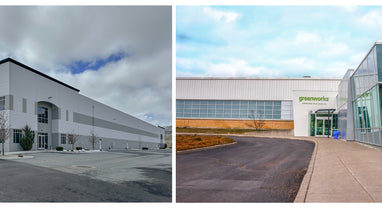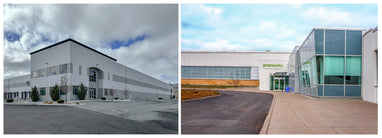Explore all Pressure Washers

Looking to dominate dirt and grime with a powerful electric pressure washer? Unleash a Greenworks pressure washer for your most challenging tasks.

Pressure Washers By Project:
Pressure Washers By PSI:
Heavy Duty: 2000+ PSI
Blast the biggest jobs like siding, driveways and boats with maximum cleaning power.
Shop NowPressure Washer Accessories:
Related Blogs:



Greenworks® Unveils Two New State-of-the-Art Facilities To Bolster Speed, Service, and Operations in North America
Learn MoreFrequently Asked Questions
What soap should I use with my pressure washer?
![]()
Can I switch between applying soap and rinsing?
![]()
Yes, you can!
For units with an onboard soap tank: Soap can only be applied with the black soap nozzle, simply switch it out for the appropriate nozzle that you require for rinsing. Allow a few seconds for the soap suds to clear from the line and then you'll have clean water.
For units that use a soap bottle: To rinse, you'll have to remove the soap bottle and reattach the wand with the appropriate nozzle that you require for rinsing.
How do I winterize my pressure washer?
![]()
See the optimum winterizing procedure below:
• Disconnect all water connections (garden hose).
• Turn on the machine for a few seconds until the remaining water in the pump exits. Turn off immediately.
• Use a pressure washer pump saver—follow instructions provided on pump saver.
• Roll up the electrical cord and hose neatly, making sure there are no kinks.
Ideally, we advise storing the machine and accessories in a room that does not reach freezing temperatures. Do not store near the furnace or other sources of heat as it may dry out the pump seals. Also note that this procedure requires using a pressure washer pump saver that can be purchased at most hardware stores.
Can I use hot water with your pressure washers?
![]()
No, we only offer cold water pressure washers. The maximum inlet water temperature should not exceed 104 °F (40 °C).
What size are the threaded fittings on the pressure washer?
![]()
All threaded connections on our pressure washers are an M22 14mm fitting.
What size are the nozzles?
![]()
Our pressure washers use ¼” quick connect nozzles.
My pressure washer will not start, or I have started the pressure washer, but it keeps shutting off after pulsating and does not reach high pressure. What’s wrong?
![]()
There are a few factors that could cause these reactions such as excess air in the pump or a clogged/faulty nozzle. See all troubleshooting options below.
Cleaning Obstructed Nozzles Over time with use, the pressure washer nozzles may collect dust, dirt, and calcium build-up which as a result cause the pressure washer to malfunction while in use. To clean nozzles, soak them in a 50/50 mixture of white vinegar and warm water for a minimum of 15 minutes. Then proceed to poke your nozzle cleaning tool or paper clip through the end of the nozzle hole to poke out any debris. After you have done this, rinse them with warm water.
Purge Air from Pressure Washer Set up the unit as per usual and ensure you are not using an extension cord. Remove any nozzle that may be connected at the end of the wand. Make sure that you have a green light on the GFCI on the power cord. Turn your garden hose on but leave the pressure washer turned OFF. With the pressure washer turned off, squeeze on the trigger for about 3 minutes, allowing the water to run through the unit at no pressure. In doing so, you're bleeding the unit out of any air that may be stuck in the pump. After 3 minutes, turn the unit on. Reinstall one of your clean nozzles and continue using the unit. At this stage, if the unit shuts off when a nozzle is installed be sure to try all nozzles. A faulty nozzle may cause the unit to shut down.
Additional components to check:
• Ensure a nozzle is connected. Be sure to try all nozzles.
• Ensure that the water source is fully opened and is at least 60PSI (Refer to: Does my water source have to be of a certain PSI to run the unit properly?)
• Check that there is at least 10' of unrestricted garden hose between the hose connection and the unit, any kinks will prevent the flow of water from going into the unit and prevent proper pressure.
• For best results, use a 1” (25 mm) or 5/8” (16 mm) garden hose.
• Check that the water inlet is not clogged. Disconnect the garden hose, remove the filter and rinse with warm water.
• Make sure you are using a working outlet. Be sure to try more than one!
What uses are the different nozzles ideal for?
![]()
0° - Red nozzle: This nozzle is typically used for removing tough stains like rust and debris from concrete and metal. You can also use it for removing caked on mud from heavy construction, farm, or lawn equipment. Do not use this nozzle on wood or home siding or for washing a car because this stream is very powerful and can damage a soft surface. 15° – Yellow nozzle: The yellow pressure washer tip provides high versatility with its
15-degree angle tip. Referred to as the washing tip, it provides plenty of pressure to remove dirt from many surfaces without damage. This pressure washer tip is designed for “sweeping” foliage or debris given its wide angle. This tip is versatile due to its wide area of cleaning and strong pressure application.
25° – Green nozzle: The green colored, 25-degree nozzle is best used to sweep away dirt and mud. Use it to sweep away leaves from decks, driveways, and sidewalks. It can also be used for removing light mildew stains, algae, and bacteria build up from pools.
40° – White nozzle: The white 40-degree tip, referred to as the “fan” tip, creates the widest area of cleaning with relatively low pressure. This pressure washer tip is best used for delicate cleaning applications. It's recommended for light cleaning on wood decks and other soft surfaces.
75° Soap – Black nozzle: The black colored nozzle is a low-pressure detergent nozzle. You use this when applying your preferred detergent for your cleaning projects.
Turbo Nozzle -This nozzle rotates in a zero-to-15-degree spray pattern in a circular motion to break down tough dirt and grime. The spray pattern can cover an area of 4 to 8 inches wide depending on the distance between the tip and the surface being cleaned.
Why isn’t my unit reaching high pressure?
![]()
Please check the following if your unit is not reaching high pressure:
• You are using a 1” (25 mm) or 5/8” (16 mm) garden hose.
• There are no kinks, leaks, or blockages at the inlet filter or in the garden or high-pressure hose.
• The water supply has been fully opened and is ideally 60 PSI (unit tolerates 45-75PSI).
• A high-pressure nozzle is installed.
• There is no air in the pump. Purge the unit by turning the machine off and pulling the gun trigger for a few minutes to release pressure then try turning the unit on.




















